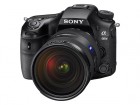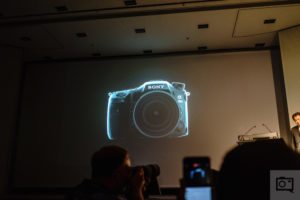
Sony’s A9 and A99 II are both ideally suited to the same kind of user, namely sports and action photographers that require speedy burst rates and rapid AF systems. Yet, the huge price difference between them may make prospective A9 purchasers sway towards the older A99 II.
So, what should anyone considering these two think about?
Design and ergonomics
As with all of Sony’s SLT models, the A99 II adopts a more traditional DSLR-like form, with a deep grip and a more rounded profile, while the A9’s more angular body is fashioned to resemble models in the popular A7 line. Both, however, make use of magnesium alloy in their construction, and both are resistant to dust and moisture.
Sony takes a very different approach to the top plates of the two models. The A99 II only sports a single dial (a mode dial), with the remainder of the controls being buttonn designed to work in conjunction with the rear controls. This also leaves space for a useful top-plate LCD, something that A9 lacks.
Sony A9
Sony A99 II
The more dial-heavy A9 allows options to be changed without you needing to keep an eye on one of the LCD screens, principally drive and focusing modes, as well as exposure compensation.
Around the back, the two follow a broadly similar idea, although the main thing that splits them is the inclusion of a rear menu pad dial on the A9.
The A99 II has an advantage with its LCD screen, however, as this can be tilted to a much broader range of positions, and even positioned to face the front, although you could argue the latter is not too vital on such a model.
Sony A9
Sony A99 II
Its resolution isn't quite as high as the A9's, though (1. 23million dots vs the A9’s 1. 44million dots) and it also doesn't offer the same touch-functionality that the A9 provides. The A9’s electronic viewfinder also offers a higher 3. 68million-dot resolution, against the A99 II’s 2. 36million dots.
Image Quality
Cameras designed for speed have traditionally offered sensors with relatively modest pixel counts, although the A99 II defied expectations by arriving with a 42. 4MP full-frame Exmor R CMOS sensor.
By contrast, the A9 has a 24. 2MP Exmor RS CMOS sensor, although this is still perfectly respectable when you consider what many of the A9’s competitors offer.
Sony A9
Sony A99 II
Both bodies have been designed with five-axis image stabilisation systems, and these can work in concert with lens-based image stabilisation too. The systems aren't quite the same, however.
Sony claims a maximum 5-stop advantage with the A9 vs 4. 5 stops with the A99 II. It’s worth remembering that these figures relate to specific circumstances, rather than what you’re likely to see in every situation.
Special Features
Two areas where the cameras differ are autofocus and burst rates.
The A99 II features a Hybrid Phase-Detect AF system that combines 79 phase-detect AF points on a separate AF sensor (including 15 cross-type points) with 399 phase-detect AF points on the main imaging sensor. As the two systems work with each other, the different orientation in which the points sense detail from each other also means that 79 effectively become cross-type points.
The Fast Hybrid AF system of the A9, meanwhile, has 693 phase-detect AF points on the imaging sensor, which cover around 93% of the frame, and 25 contrast-detect AF points.
While the A99 II can fire images at up to 12fps with autofocus and auto-exposure maintained, the A9 can manage 20fps. Not only that, but the A9 can still manage 10fps with AF tracking when using an A-mount lens via an adapter.
Sony A9
Sony A99 II
Other notable advantages of the A9 include two card slots (the A99 II only has one), as well as LAN and flash sync ports, and no blackout in either the viewfinder or on the LCD when shooting at 20fps.
The A99 II, however, is arguably better designed for videographers, with a Silent Multi-Controller that allows for changes to be made discreetly while recording videos, together with a handful of video extras (see below).
Video Quality
The two share a number of commonalities with regards to their video-recording capabilities, but they are not quite the same in every respect.
Both record 4K video to the UHD resolution of 3840 x 2160pixels, and both are capable of doing so with full pixel readout, without any pixel binning, for the benefit of picture quality - albeit slightly differently to each other.
Sony A9
Sony A99 II
The lower pixel count of the A9’s sensor allows footage to be captured at a 6K resolution before this is downsampled to 4K. Meanwhile, the much higher pixel count of the A99 II’s sensor means that the claim of no pixel binning is only valid when using the Super 35mm crop option, which records from an area covering around 15MP. This captures approx. 1. 8x more detail than necessary before this is downsampled to 4K.
Both models can record at up to 100Mbps when shooting 4K and both have clean HDMI outputs too, although the A99 II has a few extras straight out of the box. These include Picture Profiles and S-Log options, together with the Gamma Display Assist Option for the latter.
Both are also new enough to feature Sony’s Slow & Quick capture mode, which allows the user to capture footage in a choice of frame rates from 1fps to 120fps.
Conclusion
Clearly, for some people, the A99 II will be the preferred choice out of these two models.
With a wide section of native lenses, a broader range of control over 4K footage, a more flexible LCD screen and a 42MP sensor, it boasts a handful of key advantages over its cousin. And that’s before you factor in its significantly lower asking price too. Particularly if you’re already a Sony A-mount user, one looking to upgrade from an older model and with a collection of lenses, it makes a lot of sense.
Yet, the A9 belongs to a newer system, one that's more likely to see greater development in years to come. Its standout advantages include fresher sensor technology, a newer AF system, stronger battery life, faster burst rates and blackout-free shooting, and the fact that it still remains capable when partnered with A-mount lenses may be enough to sway SLT users.
. digitalrev.com2017-5-24 03:00












